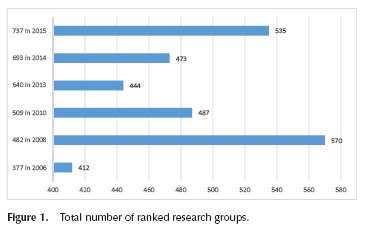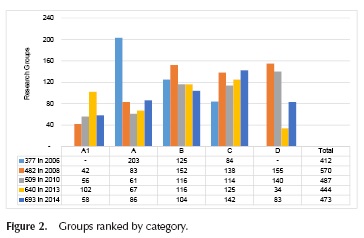Services on Demand
Journal
Article
Indicators
-
 Cited by SciELO
Cited by SciELO -
 Access statistics
Access statistics
Related links
-
 Cited by Google
Cited by Google -
 Similars in
SciELO
Similars in
SciELO -
 Similars in Google
Similars in Google
Share
Ingeniería e Investigación
Print version ISSN 0120-5609
Ing. Investig. vol.36 no.2 Bogotá May/Aug. 2016
Editorial
Results of the Universidad Nacional de Colombia's research groups ranking
The research groups ranking is a periodic activity aimed at assessing the performance of researchers and research groups, so as to promote the continuous improvement, academic exchange and visibility of the national scientific production. In previous editorial notes of Ingeniería e Investigación (Narváez, 2014; Pavas, 2015), a revision of the research groups ranking in the Universidad Nacional de Colombia - UN was presented for the last two years. Figure 1 displays the trend for the total amount of groups in the Universidad Nacional de Colombia, without recognized groups. This information will be employed throughout the current editorial note. The information was provided by the Vicerrectoría de Investigación y Extensión1 of the UN. Despite the fact that the groups' dynamics and their corresponding ranking are different in each institution, the Universidad Nacional de Colombia has the greatest number of research groups in the country. Therefore, it represents a significant sample of the Colombian research groups' behavior and the effects of the ranking model. The readers can look up the complete national results of the most recent ranking in Colciencias' website2.
In 2013 Colciencias performed several adjustments in the groups ranking model, which had as a consequence a reduction in the ranked groups and a change in the amount of A1 ranked groups.
The implementation of a new model requires adaptation from the groups. Of course, the adaptation to new rules, with its corresponding benefits, requires the continuity of the rules themselves. Pavas (2015) showed that there was a significant change in the model assessment criteria applied in 2013 in comparison to those applied in 2014, which had as a consequence a reduction of 48% of A1 ranked groups in the UN. Figure 2 shows the evolution of the most recent results.
The most recent ranking had an increase of 13% in the total amount of ranked research groups in the UN (62 groups), along with and increase of 62% (26 groups) in the A1 ranking with respect to the last year. In Pavas (2015) a reflection about the criteria employed to rank groups and their performance was suggested.
The most recent ranking shows a change in the results. Although the current model has been applied only three times, it is hard to believe that the research groups have changed remarkably their productivity in such a short time. Thus, there could be two possibilities for the new results: irst, the groups improved somehow their productivity; second, the assessment criteria got changed.
The irst possibility has different aspects. The new knowledge productivity (with the highest impact on group ranking) results from the continuous and disciplined exercise of research, aimed to reach and make results visible; this is the why it is so dificult to change it in short time lapses. Nevertheless, if the group does not register the whole information regarding its products or does so untimely, it could get misclassiied. It is noteworthy to highlight that the rankings information management system of Colciencias presents several and diverse failures that hinder the registration of information from the groups. Regardless of the operational difficulties, it is each group's responsibility to update and register all its productivity information in a timely manner. In consequence, it is possible that the groups have improved their productivity and also that they have learned to register properly their results for ranking purposes.
With respect to the second possibility, the ranking model is dynamic and its thresholds may change; but such a noticeable change from one year to the next reveals possible adjustments. Improving or lowering the ranking does not only impact the institutional indicators; it has impacts on diverse resource funding opportunities, which assign scores based on groups and researches rankings. It is important to rely on a ranking model capable of differentiating the groups according to objective criteria, but it is also necessary to sustain these criteria for a prolonged period of time to give the groups the chance to learn and improve.
The debate about the groups ranking, its impact and purpose is still open. It is important that the researchers pay attention to it and give their opinions.
Once again, the Editorial Board of Ingeniería e Investigación offers the readers a selection of the received scientific papers. We hope this new is of your interest and provides a current perspective of the advances in engineering. We invite our readers to continue sending their contributions.
Andrés Pavas
Assistant Professor Electrical and Electronic Engineering Department
Director Ingeniería e Investigación Journal
Universidad Nacional de Colombia, Bogotá, Colombia.
Notas
1 Results for the National University of Colombia (http://goo.gl/eqJacn )
2 Results for Colciencias (http://goo.gl/G87wVl)
References
Narváez Rincón, P. C. (2014). Editorial. Ingeniería e Investigación, 34(1), 3-4. [ Links ]
Pavas, A. (2015). Editorial. Ingeniería e Investigación, 35(1), 3-4. [ Links ]











 text in
text in 




